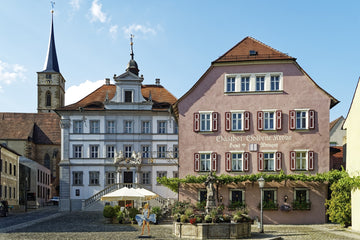Architecture in Bavarian villages that has developed over centuries is increasingly threatened by reckless new buildings and modernization projects.
Documentary filmmaker Dieter Wieland accuses: "We want to ruin our village," he says in his haunting documentary. It is a "little game of transformation" in which the Bavarian villages are losing their face.
Many of these changes involve the demolition of centuries-old buildings. The old farmhouses, which Wieland describes as the "sum of centuries of experience", embodied the uniqueness and character of their region in form and material.
They were built with care, using building materials that came from the immediate area - be it sandstone in Franconia or wood in the higher elevations of Bavaria. By using local materials, the houses were not only functional, but also ecologically and economically well thought out. The loss of these buildings means a "loss of history and identity," says Wieland.
In contrast to this are the modern buildings, which are characterized by the ruthless use of concrete and modern materials. The new buildings, which are based on industrial standards, are "faceless constructions" that seem like foreign bodies in the old village structures.
The new village image is characterized by "monotonous uniformity" because more and more builders prefer inexpensive, low-maintenance and standardized solutions. The charm of the old buildings and their symbolic connection to nature are lost. "Low-maintenance is the key word," says Wieland emphatically.
The change is not only limited to the houses. The road layout and the design of public spaces are also contributing to destroying the original atmosphere of the villages.
In one example, Wieland shows a road that runs straight through a Franconian village and has "wiped out" several old farmhouses. The roads, once intended as meeting places and places for social interaction, have now often degenerated into "hostile thoroughfares". A solution must be found urgently to restore the old community spirit, he demands.
Even the windows in old houses, which were often made with "great taste and craftsmanship", reflect the loss of traditional values. These are "the eyes of the house" and determine its expression and soul.
Today, however, large, standardized window models are replacing the traditional window crosses and sashes, which is turning the houses into "standardized test-tube houses," explains Wieland. The interior and modern furnishings of the new houses are also in clear contradiction to the simple but functional buildings of the past.
Wieland sees the cause of these developments in a ruthless consumer and advertising industry that often places the ideals of modern building and living above the cultural and landscape context.
The advertising images of modernity, which with their "sugary-sweet color photographs" suggested that new buildings offered a better life, were in many ways a deception, Wieland stressed. These new buildings, which "represent anything but rural life," were in reality often expensive, oversized and unsuitable.
Nevertheless, there is hope for the Bavarian villages. Wieland points out that consistent compliance with monument protection regulations and building specifications can help to preserve the traditional aesthetics and value of the old buildings.
In Königsberg, Lower Franconia, for example, a municipality has committed itself to an exemplary statute that strictly regulates modern, unsuitable building methods and offers subsidies for the preservation of old buildings.
This example shows that it is possible to combine modern housing needs with the preservation of traditional architecture. This would allow the villages to retain their character while offering modern comforts.
For Wieland, one thing is clear: the true value of the villages lies in their roots in history and their connection to nature. Monument protection should not be seen as an "obstacle" but rather as an "opportunity to preserve the heritage and keep the centuries-old building culture alive for future generations."
From the perspective of timeless beauty and classical aesthetics, as embodied by Forma Aeternus , the article on Dieter Wieland's criticism of the structural modernization of Bavaria's villages shows how fundamental the preservation of permanence and authenticity is for a place and its people.
The values that drive Forma Aeternus – monastic calm, robust materials and clean, authentic lines – are reflected in the traditional Bavarian buildings that Wieland so passionately defends.
Discover the fascination of timeless design, the tranquility of monasticism and the power of sustainable materials. Subscribe to the Forma Aeternus newsletter and receive regular inspiration, insights into our projects and exclusive news about our mission for authentic, sustainable product design and traditional craftsmanship.







